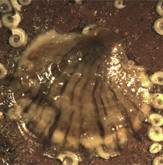Spatial and temporal variation in settlement of the Olympia
oyster, Ostrea lurida, in Newport Bay, CA.
My research focuses on the only species of oyster that is native
to the west coast of the United States, Ostrea lurida.
This oyster was once abundant along the coast but in the early
1900s, pollution and over-harvesting lead to significant
population crashes. There are currently many restoration
projects taking place in Oregon, Washington and northern
California, but little is understood about what factors control
population growth. Processes controlling settlement dynamics of
this species are of particular interest because we can exploit
natural settlement of spat for seeding restoration habitat.
I am interested in studying this species’ settlement patterns
over time throughout one estuary. I was formerly in charge of
monitoring settlement at six sites in Newport Bay using ceramic
settlement tiles attached to PVC tees. The ambient temperature
has been continuously monitored by attaching small Tidbit™
loggers to my settlement tees. This research has been ongoing in
the Zacherl lab for five years and now other undergraduates in
the lab are in charge of it.
Factors influencing settlement choice of the Olympia oyster,
Ostrea lurida: tidal height and distance from bottom
I am also interested in studying the settlement of the oyster
larvae as a function of tidal height. It would be useful to know
if there was a particular depth or height from the bottom at
which the oysters can settle. This information will help those
who are performing restoration projects to efficiently collect
the maximum amount of spat. A preliminary study was done where
an apparatus was deployed using SCUBA divers. We found that we
could not separate the effects of tidal height and distance from
the bottom so I performed another study. Once again, PVC tees
were set out over two weeks at varying distances from the bottom
as well as tidal heights.
These
studies are all ongoing.

